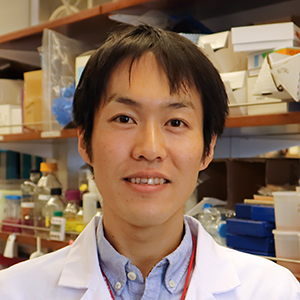Exploring the roles of EZH2 mutation for the development of double hit lymphoma and acquisition of chemotherapy resistance

Yusuke Isshiki
MD PhDWeill Cornell Medicine
Project Term: July 1, 2023 - June 30, 2025
We aim to clarify the role of EZH2 mutations in the development of double hit lymphoma (DHL) and acquisition of chemo-resistance. We confirmed that Ezh2 mutation is essential to develop aggressive murine GCB lymphoma and deplete T cells from tumor in combination with BCL2 and MYC. The mice showed resistance to chemotherapy and the combination with EZH2 inhibitors improve the outcome in vivo. Our goal is to show the synergy and propose a new mechanism-based therapeutic approach for DHL.
Germinal centers play a major role to obtain high-affinity antibodies against pathogens through the acquisition of somatic hypermutations, and germinal center B (GCB) cells are at a high risk of malignant transformation due to genomic instability. Double hit lymphoma (DHL) is a unique subtype of GCB-origin lymphoma that is defined by MYC and BCL2 translocation which results in the ectopic expression of the proteins. The prognosis of DHL is very poor when the patients are treated with standard R-CHOP therapy, however, none of the treatments have shown superior outcomes. Gain-of-function mutations of histone modifier gene EZH2 that is responsible for epigenetic gene silencing are found in more than 50% of patients with DHL. Our preliminary results also showed that Ezh2-mutant murine GCB lymphoma cells with BCL2 overexpression are more resistant to chemotherapy-induced DNA damage than Ezh2WT cells. Therefore, we hypothesized that EZH2 mutation plays important role in the development of DHL and the acquisition of chemo-resistance. We specifically aim to 1) Discover the role of EZH2 mutation in the development of DHL, 2) Explore whether EZH2 mutation contributes to depleting T cells in the DHL microenvironment, 3) Determine the role of EZH2 mutation for the acquisition of chemo-resistance in DHL. We generated a new mouse model that specifically overexpresses BCL2 and MYC and acquires Ezh2 mutation in GCB cells (BCL2Ezh2MYC mice). The mice developed highly aggressive lymphoma which showed the monotonous expansion of GCB lymphoma cells and severe reduction of T cells in the microenvironment. On the other hand, BCL2MYC mice were not able to retain B cells in GC and showed longer survival, suggesting that Ezh2 mutation is required to develop aggressive GCB-lymphoma in combination with BCL2 and MYC. BCL2Ezh2MYC mice showed resistance to CHOP-like chemotherapy in vivo, however, combination with tazemetostat, an FDA-approved EZH2 inhibitor, dramatically enhanced the killing of lymphoma cells. We also confirmed that pre-treatment with tazemetostat significantly increased DNA damage after chemotherapy on Ezh2-mutant murine GCB lymphoma cells in vitro. Our goal is to show the synergy and propose a new mechanism-based therapeutic approach for DHL. Since tazemetostat is already approved by FDA as a treatment for B cell lymphoma, we will plan to start a clinical trial with our clinical team in NY Presbyterian Hospital to overcome the unmet need for DHL.